Cross selling: increase the average number of items in the basket
In the first part of the “ Profitable Online Store ” series, we talked about the main metrics and ways to increase profits. In this article, we will consider in detail the main way to increase the average number of products in the basket - cross selling.
Cross selling - literally: cross selling. The effectiveness of this method in the West has long been known. So, in 2006, Amazon said that 35% of all sales were cross-linked.
The essence of this method is that the user who buys a product is invited to buy a number of additional products that are in line with his interests.
How to use this tool: what to offer, to whom to offer, under what circumstances and in what form? Answers to these questions require an understanding of the mechanism of cross-selling, and knowledge of how to implement it. So, what do you need to know in order to develop an individual strategy for effective cross-selling?
The determining factor in the effectiveness of cross-selling is the relevance of the proposal. The concept of relevance can be defined as follows:
Offer the right user the right product at the right time in the right place.
Any visitor to the online store is at one of the 3 conditional stages of solving his problem or satisfying a need:
Obviously, the most promising for cross-selling visitors belong to the third group - to those who have already decided on how to solve their problems and are going to make a purchase. The product that they are going to buy is a pointer to a problem or need that a visitor has. Knowledge of the problem and the needs of the user allows you to select the actual products for cross-sell offers.
We conditionally divide the goods involved in cross-selling into complementary and spontaneous.
Complementary goods or services
As the name implies, complement the selected product to complete the most complete "solution" of the user's problem. For example, Natalya buys a reflex camera. The list of recommendations for Natalia will include a lens, memory card, case + tripod. An example of such a solution is cross sell, sold in the Svyaznoy store.
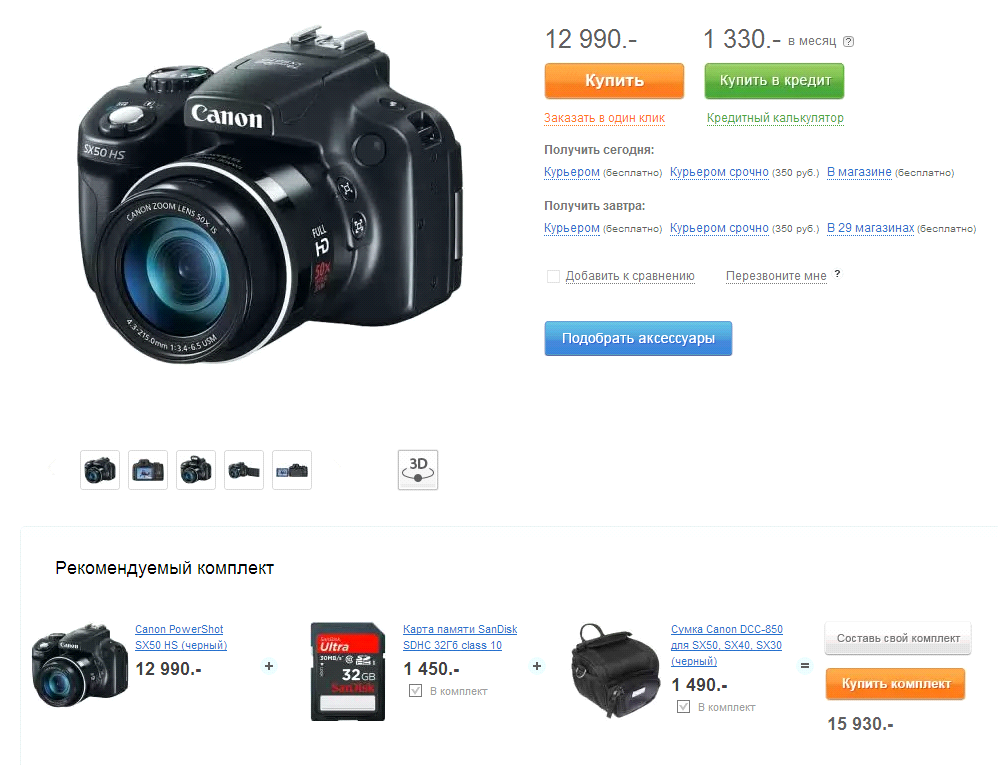
Spontaneous goods
These are goods purchased under the influence of emotions. Such products do not directly complement the purchase, but are indirectly related to it.
For example, Ivan plans to buy a boat. They recommend that he buy a pump (complementary product), a garden roller, barbecue, spinning and a picnic set (spontaneous goods) for the boat.
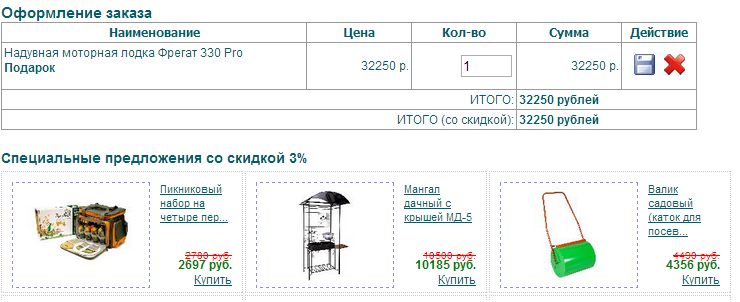
When implementing cross-selling, priority is given to complementary goods and services that may constitute a “decision”. If the target product does not include additions, then spontaneous goods are used.

According to the established traditions of online merchandising, the cross-selling widget is placed on the product page, in the basket, on the confirmation page for adding the product to the basket and in the e-mail letters. The choice of a specific location is determined by the user scenarios of a particular online store.
Let's look at examples.
Cross sell on the product card and in the basket
Eldorado offers additional products in the form of a set of additional products on the product card.
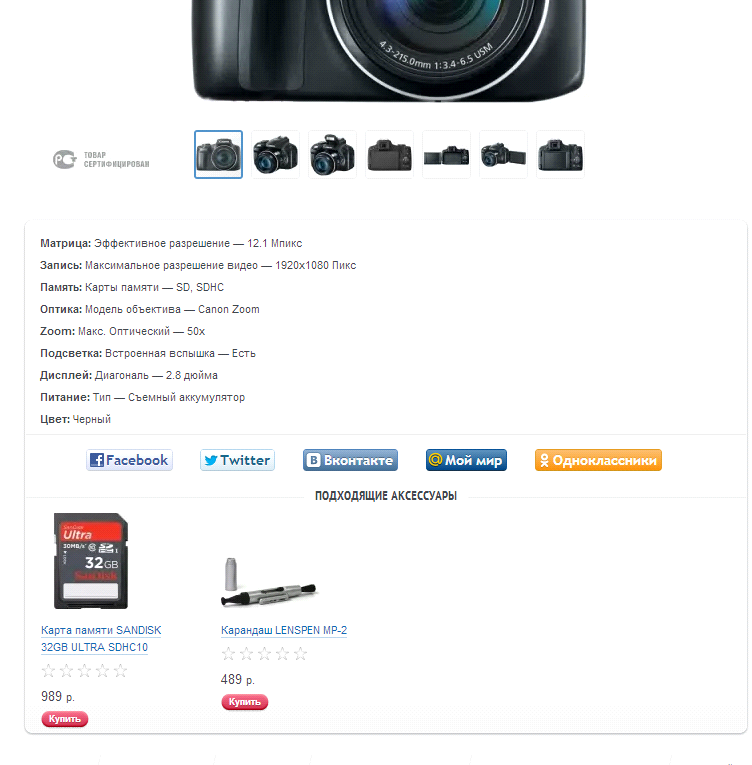
The second attempt to capture the user's attention is made in the basket.
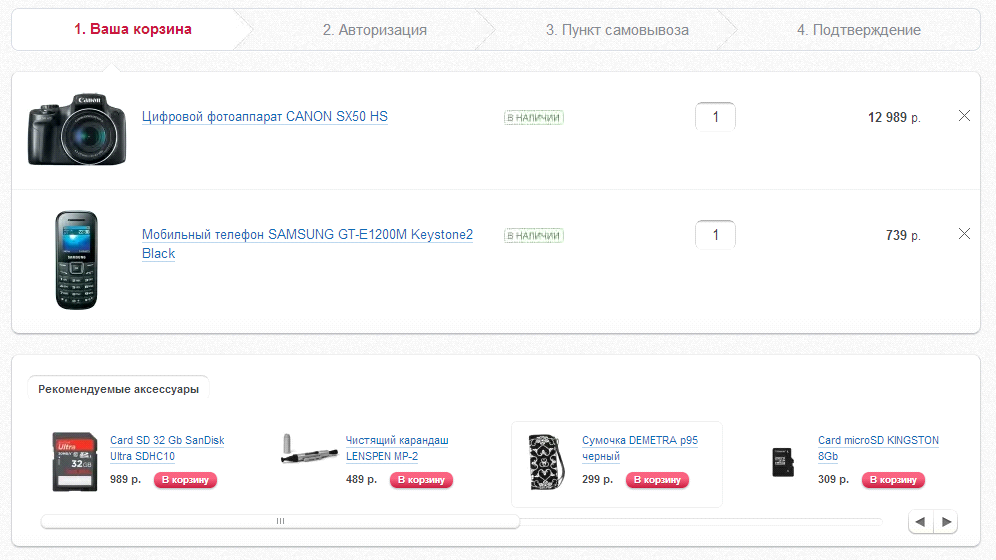
Similarly designed card Sotmarketa. So that the contents of the block do not go unnoticed, cross sell is placed before the fold.
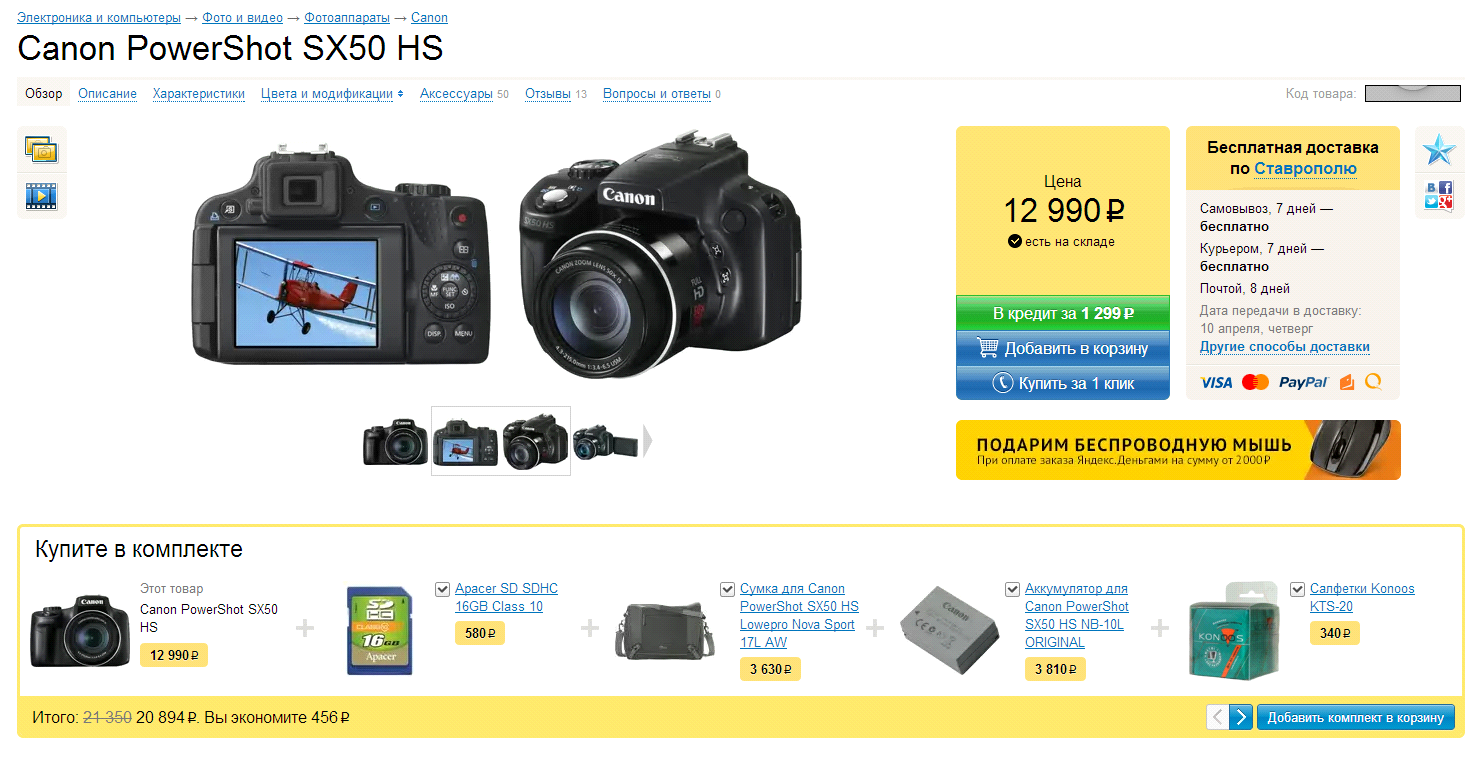
In the basket we are immediately greeted by two blocks of cross-selling: the slider on the right, which reflects the recommended kit for a particular product and the general block.
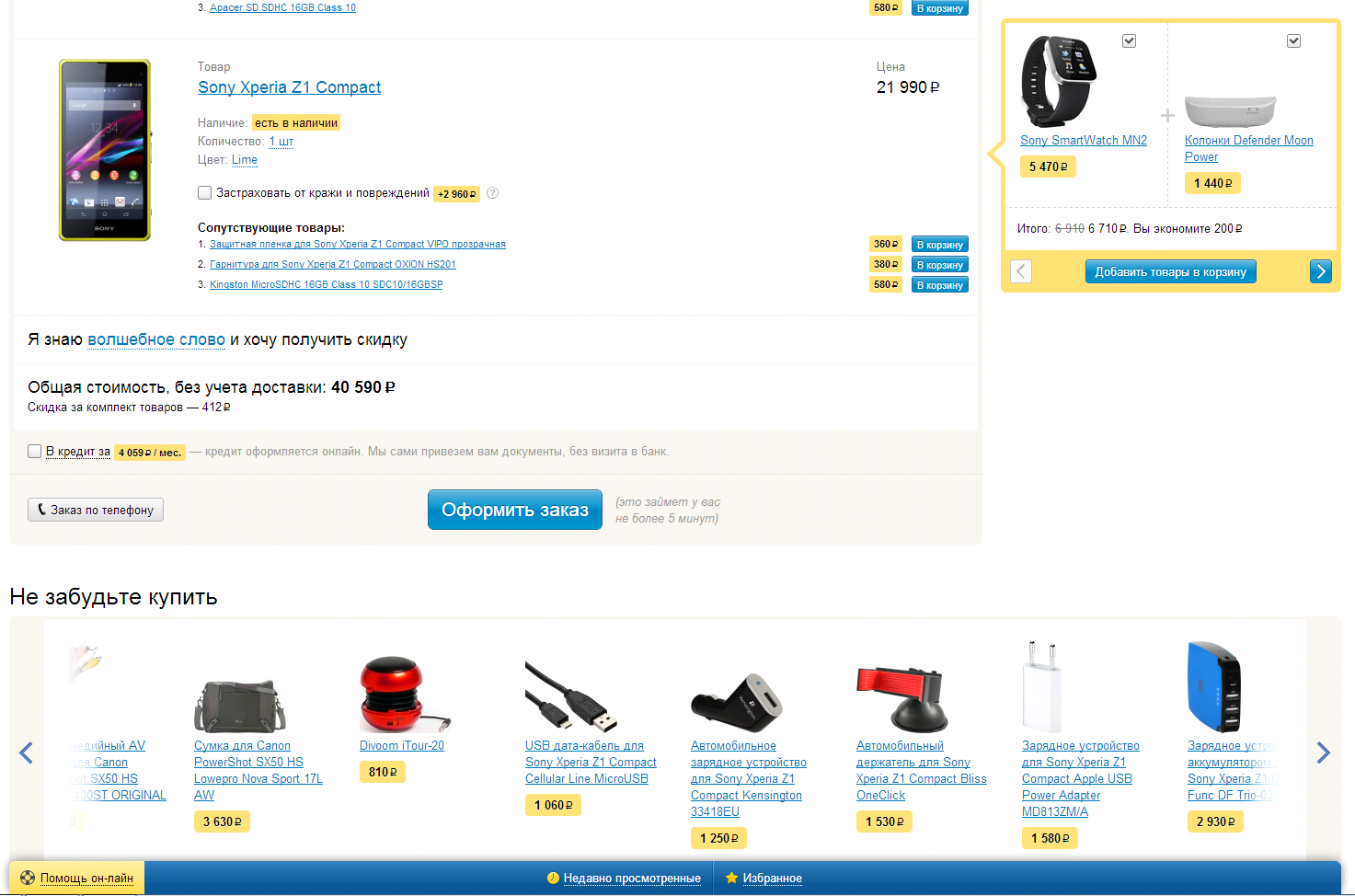
When the “solution” offered to the client consists of several groups of goods and services, then marking can be used - a multicomponent widget in which the user can independently choose a complete set.
Example: a user buys the first bike, and he needs to purchase related products. Cross sell acts as a consultant, organizing and recommending the necessary “solution”.

Labeling of goods or services makes it easier for the user to select, but without a guarantee of compatibility of the recommended and target goods, it is not worth doing it.
Cross sell on the order confirmation page
Some companies use the confirmation page for cross-selling.
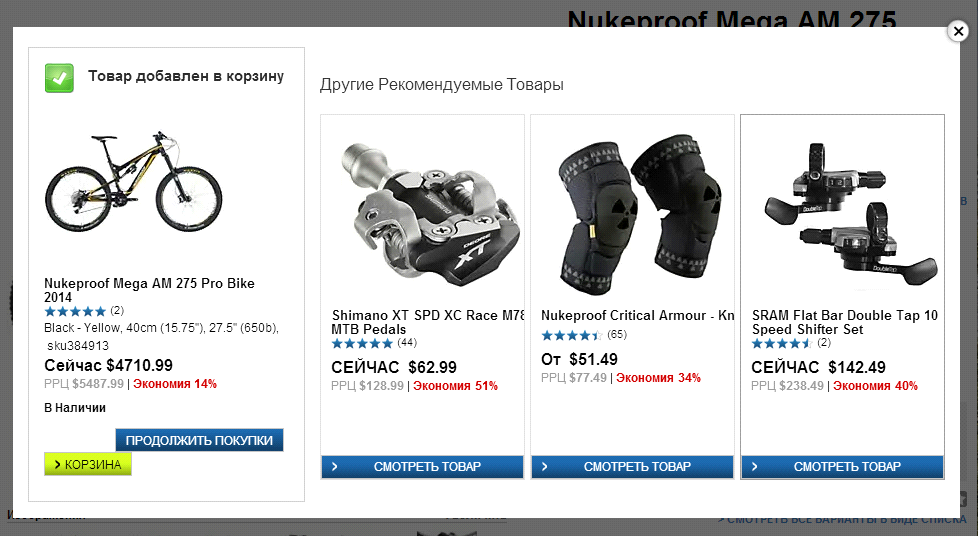
As a rule, this method is duplicated with other options for placing the cross sell widget, since the user may accidentally close this window.
OZON does not use an intermediate pop-up window, but when the status "in the basket" changes, a notification appears recommending a suitable product.
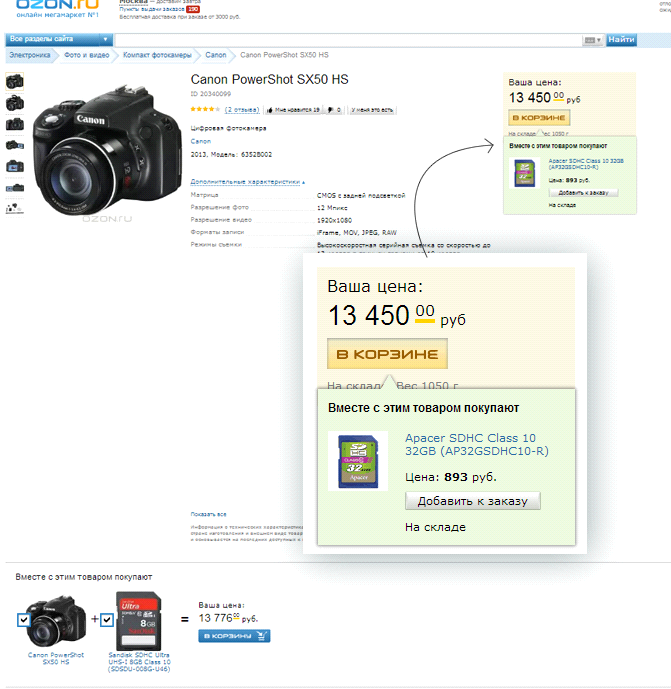
Cross sell in the e-mail marketing system
Cross sales in the online store can be moved outside the site. For example, in the e-mail newsletter. The ideal option is cross sell in service letters of order confirmation, issued in one-click order format.
Here's how OZON solves this problem.
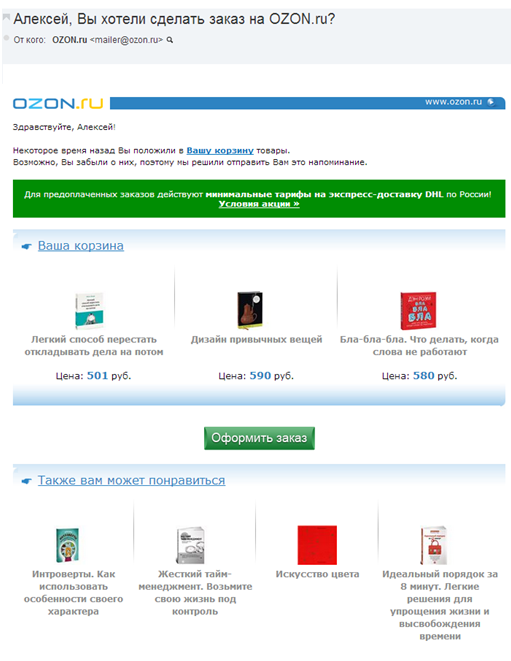
Finally, I will share observations on the implementation of the cross sell widget in the online store:
Remember, cross-selling is a continuation of user scenarios that are individual for each store.
Cross selling - literally: cross selling. The effectiveness of this method in the West has long been known. So, in 2006, Amazon said that 35% of all sales were cross-linked.
The essence of this method is that the user who buys a product is invited to buy a number of additional products that are in line with his interests.
How to use this tool: what to offer, to whom to offer, under what circumstances and in what form? Answers to these questions require an understanding of the mechanism of cross-selling, and knowledge of how to implement it. So, what do you need to know in order to develop an individual strategy for effective cross-selling?
How cross selling works
The determining factor in the effectiveness of cross-selling is the relevance of the proposal. The concept of relevance can be defined as follows:
Offer the right user the right product at the right time in the right place.
Any visitor to the online store is at one of the 3 conditional stages of solving his problem or satisfying a need:
- Training (finding ways to solve his problem or meet his needs)
- Choice (assessment and analysis of the solutions to the problem)
- Purchase (purchase of goods).
Obviously, the most promising for cross-selling visitors belong to the third group - to those who have already decided on how to solve their problems and are going to make a purchase. The product that they are going to buy is a pointer to a problem or need that a visitor has. Knowledge of the problem and the needs of the user allows you to select the actual products for cross-sell offers.
We conditionally divide the goods involved in cross-selling into complementary and spontaneous.
Complementary goods or services
As the name implies, complement the selected product to complete the most complete "solution" of the user's problem. For example, Natalya buys a reflex camera. The list of recommendations for Natalia will include a lens, memory card, case + tripod. An example of such a solution is cross sell, sold in the Svyaznoy store.

Spontaneous goods
These are goods purchased under the influence of emotions. Such products do not directly complement the purchase, but are indirectly related to it.
For example, Ivan plans to buy a boat. They recommend that he buy a pump (complementary product), a garden roller, barbecue, spinning and a picnic set (spontaneous goods) for the boat.

When implementing cross-selling, priority is given to complementary goods and services that may constitute a “decision”. If the target product does not include additions, then spontaneous goods are used.

Cross Selling Widget Layout Options
According to the established traditions of online merchandising, the cross-selling widget is placed on the product page, in the basket, on the confirmation page for adding the product to the basket and in the e-mail letters. The choice of a specific location is determined by the user scenarios of a particular online store.
Let's look at examples.
Cross sell on the product card and in the basket
Eldorado offers additional products in the form of a set of additional products on the product card.

The second attempt to capture the user's attention is made in the basket.

Similarly designed card Sotmarketa. So that the contents of the block do not go unnoticed, cross sell is placed before the fold.

In the basket we are immediately greeted by two blocks of cross-selling: the slider on the right, which reflects the recommended kit for a particular product and the general block.

When the “solution” offered to the client consists of several groups of goods and services, then marking can be used - a multicomponent widget in which the user can independently choose a complete set.
Example: a user buys the first bike, and he needs to purchase related products. Cross sell acts as a consultant, organizing and recommending the necessary “solution”.

Labeling of goods or services makes it easier for the user to select, but without a guarantee of compatibility of the recommended and target goods, it is not worth doing it.
Cross sell on the order confirmation page
Some companies use the confirmation page for cross-selling.

As a rule, this method is duplicated with other options for placing the cross sell widget, since the user may accidentally close this window.
OZON does not use an intermediate pop-up window, but when the status "in the basket" changes, a notification appears recommending a suitable product.

Cross sell in the e-mail marketing system
Cross sales in the online store can be moved outside the site. For example, in the e-mail newsletter. The ideal option is cross sell in service letters of order confirmation, issued in one-click order format.
Here's how OZON solves this problem.

Cross Selling Strategy Tips
- Use data about user preferences
Information about pages viewed, pending products and so on. - Be timely
Road spoon for dinner, and cross-products until they are bought elsewhere. - Motivate
Use discounts, special delivery conditions, expert recommendations, and other social evidence to add value to cross-products. - Measure and analyze the results. Fix
all changes in the cross-selling strategy. Leave the most workable results.
Finally, I will share observations on the implementation of the cross sell widget in the online store:
- A cross-selling widget should be noticed, but should not distract attention from the target product.
- The widget should not be overloaded with information.
- Recommendations should meet expectations, and ideally warn them.
- With a large assortment of cross-products, labeling is appropriate.
- Sell a “solution”, not a product (use user stereotypes)
- Use personalized recommendations to return a client through the e-mail marketing system.
- Use high margin products for cross selling.
- Use the rotation principle so that it does not merge with the up-sell widget.
Remember, cross-selling is a continuation of user scenarios that are individual for each store.
